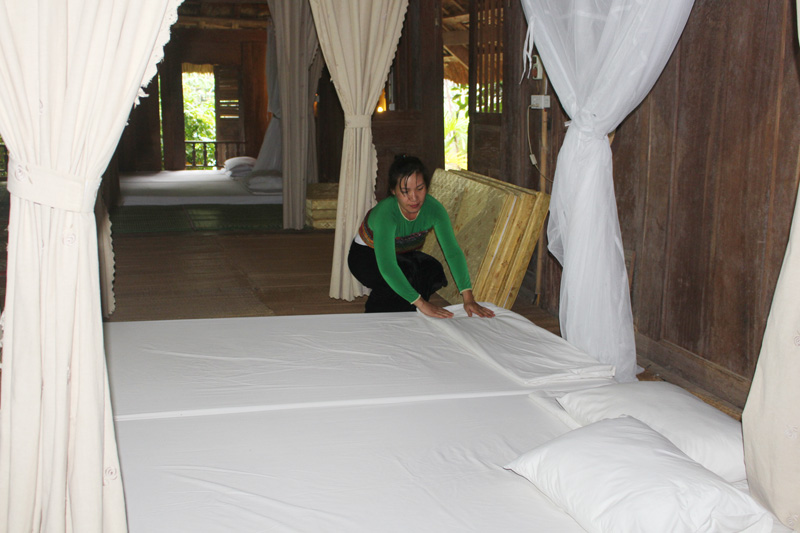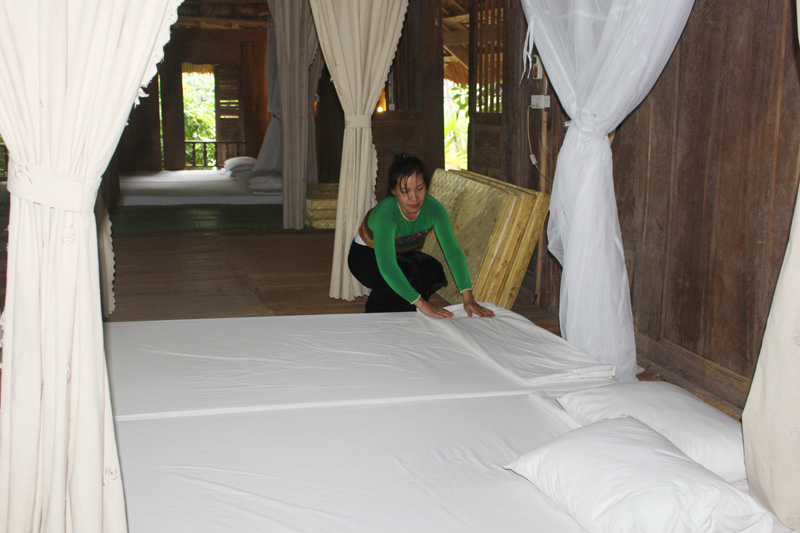
(HBO) – Untouched rustic Mai Hich commune, which is emblazoned with ripen rice terraces surrounded by mountain ranges and trails covered by white smoke streaking from local houses’ roofs, has grown in stature among domestic and international visitors in recent years.
Photo:
Homestay Minh Tho in Hich 2 village, Mai Hich commune (Mai Chau district) is a
favourable accommodation among travel companies.
Community-based
tourism has undergone positive changes and brought stable income to local
people. There are seven households offering homestay services and three
villages developing community-based tourism, comprising Hich 1, Hich 2 and Cha
Lang. In the first half of the year, the commune welcomed over 1,600 visitors, 900
of whom are foreigners, and raked in nearly 600 million VND in tourism revenue.
The commune has mobilised locals to promote community-based tourism after
seeing its economic benefits. It has also asked the locals to pay attention to
ensuring environmental hygiene to lure more holiday-makers to the locality.
Connections between villages and tourist attractions help visitors have
brilliant experience during their stay.
Ha Cong Minh, a homestay owner in Hich 2 village, said: "How to make tourists
feel comfortable and enjoyable is what we care. We have teamed up with travel
agents to set up tours for visitors to go sightseeing, enjoy stunning views of
waterfalls and landscape of rural areas as well as involve in local activities
like rice harvesting, fishing, brocading and experience traditional dishes and
cultural exchange.
The Centre for Community Health and Development (COHED) has supported homestay
service providers in Hich 2 village with necessary skills and knowledge as well
as capital to develop community-based tourism since 2010. The commune is home
to 120 Thai ethnic families, who have preserved nearly 90 percent of their
traditional stilt houses.
Bestowed with natural landscapes and tourism investment, coupled with local
hospitality, Mai Hich has become an attractive draw for tourists to discover
spectacular sceneries and ethnic traditional culture. It is expected to make
community-based tourism a major currency earner of the commune./.
Located just a 20-minute drive from Hoa Binh City, Ora Hill Farmstay & Glamping Hoa Binh is a captivating new destination nestled in Mo hamlet, Bình Thanh commune, Cao Phong district. Combining farming with leisure, this tranquil retreat is perfect for those seeking balance, joy, and an immersive experience in the expansive beauty of nature.
Muong Bi - Tan Lac is renowned as one of the four famous Muong regions in Hoa Binh province. Blessed by nature with a favourable climate and stunning landscapes, Tan Lac holds great advantages for tourism development. The local tourism industry has made remarkable strides in recent times thanks to the attention and support from the local authorities and sectors.
With its strategic location, well-developed transport network, and diverse soil and climatic conditions, Hoa Binh is emerging as a must-visit destination in Vietnam's northwestern tourism corridor. The province boasts numerous attractions, including the Kim Boi hot springs (Kim Boi district), the Dau Rong cave complex (Cao Phong), the Mai Chau valley (Mai Chau), and the iconic Hoa Binh hydropower plant.
The northern mountainous province of Hoa Binh has been listed among the 71 most beautiful places to visit worldwide by the prestigious US travel magazine Condé Nast Traveller.
Hoa Binh province’s rich natural and cultural resources position it as a prime location for developing community-based tourism (CBT). In recent years, support from central and provincial policies, as well as assistance from non-governmental organisations, have encouraged local ethnic minority and mountainous communities to actively engage in the sector.



